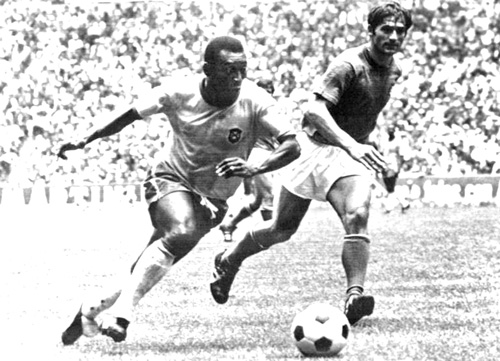Paris
Fifty years ago, modern football was born at the World Cup in Mexico, kicking and yelling, and live in vibrant colour for a global audience.
Sunday marks the anniversary of the final of that 1970 tournament which was won by Brazil’s technicolour team. Mexico in 1970 was not the first World Cup broadcast live.
Four years earlier 400 million watched England beat West Germany in the final. But that tournament was shown in black and white.
Battered Brazil, the reigning champions, limped out playing, as far as viewers could tell, in two shades of grey.
In Mexico, their yellow, blue and green glowed in the sunshine. Most viewers still watched in black and white. But the games were shot in colour and when the many iconic moments are replayed, that is how they are seen. And that is how the competition is remembered, even by its greatest star.
“I watch it because there are a lot of videos available and TV programmes,” Pele told FIFA’s website. “If I’m not careful, I always start crying.”
The tournament gave Pele his third winner’s medal but the images also cemented his reputation as the world’s greatest player, partly because of three spectacular near misses: a shot from his own half against Czechoslovakia, a header saved by England’s Gordon Banks and the dummy that almost turned a Tostao pass into a goal against Uruguay.
“I was at my peak,” Pele said. “We had a fantastic side and everyone expected us to win, which gave me the shakes.”
His strike partner Tostao wrote in his column in Brazilian newspaper Folha recently that Pele “wanted to end his international career with a great triumph, both individually and collectively, so no one would have any doubts that he was the best of all time.”
The quarter-finals all kicked off at noon on June 14. Gigi Riva scored twice and Gianni Rivera once as Italy beat hosts Mexico 4-1.
Rivellino, Tostao and Jairzinho, but not Pele, scored as Brazil beat Peru 4-2. “There were four 10 shirts in that team,” Teofilo Cubillas, one of Peru’s scorers, told the Brazil football federation web site. “If you scored four goals, they would go there and score eight.
Reigning champions England, with many of the stars of 1966 but not an ailing Banks and not, by the end, Bobby Charlton, substituted with his team two goals up to protect him from the heat, lost 3-2 in extra time to West Germany. Franz Beckenbauer and Gerd Mueller were among the German scorers.
In the semi-finals, in Guadalajara, Brazil gave Uruguay a one-goal start but won 3-1. Again Pele didn’t score, but Clodoaldo, Jairzinho and Rivellino did.
In Mexico City, the other semi-final was heading for a 1-0 Italian win until Karl-Heinz Schnellinger scored a 90th-minute equaliser for West Germany. Extra time was 30 minutes of mayhem. Mueller gave West Germany the lead. Tarcisio Burgnich levelled and Riva put Italy ahead. Mueller replied, but a minute later Rivera gave Italy victory.
The abiding image is of Beckenbauer playing much of the game extravagantly strapped after dislocating a shoulder when West Germany had already used both substitutes. Italy were a good team, with the extravagantly gifted Sandro Mazzola. The defence was built on the great Inter Milan side, pioneers of ‘catenaccio’, with Giacinto Facchetti at its heart. Brazil tore them apart.
At an altitude of 2,200 metres (7,200 feet) in dazzling sunshine in the Azteca, Brazil produced a display of attacking football that touched Olympian heights.
Mario Zagallo, Brazil’s coach, later said he thought the 1-0 victory over England “was the best game of the tournament…a high-class game of chess.”
Yet Brazil’s attacking display in the first colour World Cup final set a benchmark against which every one of the tens of thousands of matches broadcast since is measured.
Pele gave Brazil the lead with his fourth goal of the competition. “I told myself before the game, he’s made of skin and bones just like everyone else—but I was wrong,” Burgnich said later.
Roberto Boninsegna levelled, but in the second half Gerson and Jairzinho put the match beyond reach.
It was as if Brazil were inventing football. They finished with a flourish, scoring one of the great team goals with four minutes left as full-back Carlos Alberto finished a mesmerising eight-man move by lashing home Pele’s deft pass.
“I realise how beautiful and how important that goal was, because everybody is still talking about it,” Carlos Alberto told the BBC years later. “Nobody talks about Pele’s goal, the first goal, the second goal. It is always about the fourth goal. I think it was the best goal ever scored in a World Cup.”
It was a fitting exclamation mark at the end of what might have been the best World Cup.—APP










